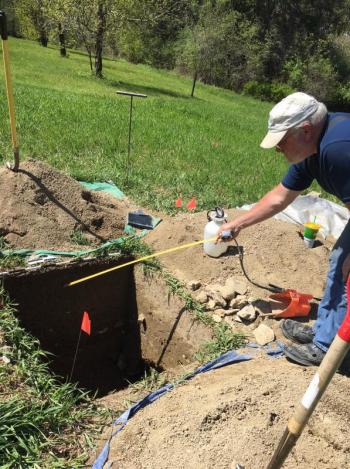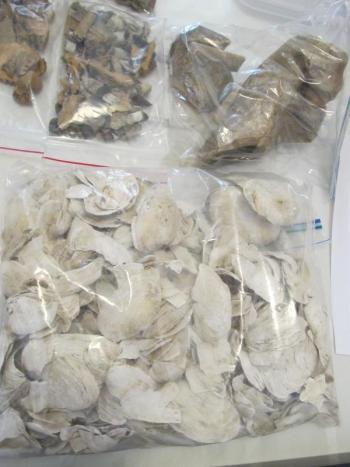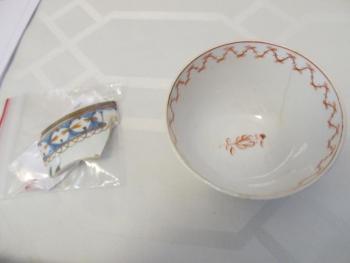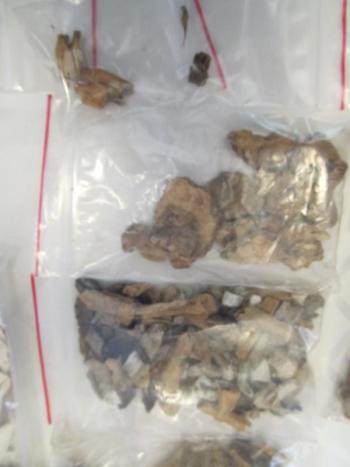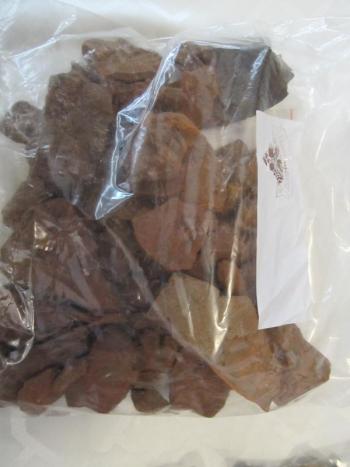Archeologist reveals what he found at Merryspring to packed audience
One man’s trash is an archeologist’s dream, only it’s not called “trash”—it’s called “cultural material.”
Harbour Mitchell, an archeologist for the last 30 years, has worked for the University of Maine, the Maine Historic Preservation Commission in Augusta, the U.S. Dept. of Agriculture, and professional archaeological contractors throughout the region.
On a visit to Merryspring Nature Center in early 2018, Mitchell asked to see a cellar hole located near the north meadow. The federal style farm house that once likely stood over the cellar, belonged to Asa Hosmer, who bought Lot 71 in 1803.
On his way back from the cellar, what Mitchell didn’t expect was to stumble across another historic site. Only someone with a trained eye would have even noticed a strange, cellar sized depression in the meadow. Believing it to be a second, filled-in cellar, he got the blessing of Merryspring’s trustees and began an archaeological dig, which lasted through the summer months and into the fall of 2018.
With help from assistants, Mitchell uncovered over 1,000 pieces of pottery called “sherds,” dozens of nails, brick, shards of glass, table knives, glass and clay beads, and more from this very early “homestead.” What was not found were alcohol bottles or pipes, which Mitchell said was “highly unusual … for an 18th Century site.”
Piecing together the fragments of material culture with the history records of this area, Mitchell hypothesized that there was probably an occupation in Merryspring’s meadow as early as the Revolutionary War, and which may have included both the Continental Militia (independent soldiers) and Penobscot Native Americans.
Recall that until the Revolutionary War, Maine was still a province of Massachusetts, one of the 13 colonies. In August, 1779, in an effort to help free the colonies of English rule, more than 250 militia and 40 Penobscot warriors left Glen Cove (now “Rockport” today) to fight the British in Castine. The Continental forces were badly beaten, and retreated back through the forests, many on their way back to Boston. But, not everyone wanted to leave the beautiful, resource-rich areas of what we now know today was Maine. After the war, a number of, now United States citizens settled on Lot 71, which is what Merryspring Nature Center was called back then.
“There clearly is a long term occupation in [the] 1780s and ‘90s on that Merryspring property,” said Mitchell, who gave a speech of his findings to a packed house at Merryspring last month.
“The depression that we found was a cellar hole, which at one point probably sat underneath a small, one story home,” he said. “It could have been up on posts, which after 30 years, would have rotted away. The house could have been in good shape, but the bottom of it was disintegrating. Somebody bought the lot in the late 1790s and the homestead house was moved off the foundation. From the dig we surmised they used that earthen cellar as a place to dump stuff. It was a combination of all of the construction materials for the new house and has all of the ceramics that could have been available at that time.”
Included in the pottery sherds Mitchell recovered is China Glaze Pearlware, Chinese Exported porcelain, English Fazackerly delft and English Creamware to mention a few.
“This [is] imported pottery brought over by boat [and] used by one family for a year or two, then another family [lived there] for a year for two,” he said. “This was inexpensive, mass-produced pottery, sort of like the Wal-Mart pottery of that time period. It was used, broken and thrown away. Then, the cellar was filled up… and [the field] used for pasture in the early 1800s.”
The other materials he recovered in the field, clay and glass beads, suggested that, after the battle for Castine, a number of Penobscot warriors may have also retreated back to this same area. While it’s not known whether the families (now United States citizens) and Native Americans lived with one another after the war, it’s likely they knew one another and crossed paths occasionally.
As a result of the effort by Mitchell and a few dedicated volunteers, we now have a window into how “life might have been” in the very earliest days of Camden and Rockport.
To learn more about Merryspring Nature Center, and it’s flora, fauna and history, visit their Lending Library, or stroll the grounds at 30 Conway Rd., in Camden.
Article written with assistance from Harbour Mitchell.
Kay Stephens can be reached at news@penbaypilot.com


